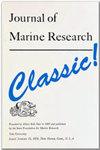Mikroplastik yang Ditemukan di Perairan Karangjahe, Rembang, Jawa Tengah
IF 0.5
4区 地球科学
Q3 Earth and Planetary Sciences
引用次数: 3
Abstract
Sampah merupakan masalah bagi masyarakat di seluruh dunia, baik sampah yang berasal dari daratan maupun laut. Permasalahan sampah di Indonesia adalah masalah yang belum terselesaikan hingga saat ini, sementara itu dengan bertambahnya jumlah penduduk maka akan mengikuti pula bertambahnya volume timbulan sampah yang dihasilkan dari aktivitas manusia. Salah satu jenis sampah yang paling banyak terdapat di wilayah daratan dan lautan adalah sampah plastik. Sampah plastik akan mengalami terfragmentasi menjadi partikel-partikel kecil plastik yang disebut mikroplastik. Mikroplastik merupakan sampah plastik yang berukuran kecil atau <5 mm yang telah mengalami degradasi dari ukuran plastik yang lebih besar. Mikroplastik sangat mempengaruhi organisme laut yang menempati tingkat trofik yang kecil, seperti plankton yang memiliki sifat filter feeder jika mengkonsumsi mikroplastik akan berdampak pada organisme yang memiliki tingkat trofik yang lebih besar melalui proses bioakumulasi. Penelitian ini bertujuan untuk mengindentifikasi kandungan mikroplastik pada sedimen dan permukaan perairan di Pantai Karangjahe. Penelitian ini dilakukan di Pantai Karang Jahe Rembang, untuk pengambilan sampel dan analisis sampel dilakukan di Laboratorium. Sampel air diambil menggunakan plankton net dengan ukuran mesh size 0,4mm dan sampel sedimen diambil menggunakan pipa paralon dengan ukuran 4 inchi dengan panjang 50cm. Untuk pengambilan sampel air disetiap stasiunnya terbagi menjadi 3 titik dengan jarak 10m setiap titiknya. Pengambilan sampel air sebanyak 25 kali dan setiap sekali pengambilan sampel air sebanyak 1L air, volume air yang telah tersaring sebanyak 25L. Setelah disaring, sampel dimasukkan kedalam botol sampel yang berukuran 250ml yang telah diberi label. Botol sampel dimasukkan kedalam cool box. Pengambilan sampel sedimen terbagi menjadi 3 stasiun dan pada 3 titik kedalaman yang berbeda yaitu 10cm, 20cm, dan 30cm. Sampel sedimen diambil sebanyak ±500g dari setiap titiknya. Kemudian sampel sedimen yang telah diambil dimasukkan kedalam plastik sampel dan diberi tanda tiap plastik tersebut. Sampel air dan sedimen dibawa ke laboratorium untuk diidentifikasi. Mikroplastik yang ditemukan di sampel air yaitu jenis mikroplastik fiber, fragment, film, dan foam. Pada sampel sedimen ditemukan 3 jenis mikroplastik yaitu fiber, fragment, dan film. Rubbish is a problem for people around the world, both from land and sea. The waste problem in Indonesia is a problem that has not been resolved until now, meanwhile with the increase in population, it will also follow the increase in the volume of waste generated from human activities. One of the most common types of waste found in land and ocean areas is plastic waste. Plastic waste will be fragmented into small plastic particles called microplastics. Microplastics are small plastic wastes or <5 mm that have been degraded from larger plastic sizes. Microplastics greatly affect marine organisms that occupy a small trophic level, such as plankton which has filter feeder properties if consuming microplastics will have an impact on organisms that have a larger trophic level through the bioaccumulation process. This study aims to identify the content of microplastics in sediments and surface waters at Karangjahe Beach. This research was conducted at Karang Jahe Beach, Rembang, for sampling and sample analysis was carried out in the laboratory. Water samples were taken using a plankton net with a mesh size of 0.4 mm and sediment samples were taken using a 4 inch paralon pipe with a length of 50 cm. For water sampling, each station is divided into 3 points with a distance of 10 m from each point. Sampling of water as much as 25 times and every time the water sample is 1L of water, the volume of water that has been filtered is 25L. After filtering, the sample was put into a 250 ml sample bottle that had been labeled. The sample bottle is put into a cool box. Sediment sampling was divided into 3 stations and at 3 different depth points, namely 10cm, 20cm, and 30cm. Sediment samples were taken as much as ± 500g from each point. Then the sediment samples that have been taken are put into sample plastics and marked with each plastic. Water and sediment samples were brought to the laboratory for identification. The microplastics found in the water samples were fiber, fragment, film, and foam microplastic types. The sediment samples found 3 types of microplastics, namely fiber, fragment, and film.在爪哇中部朗干姜的海水中发现的微塑料
垃圾对世界各地的人们来说都是一个问题,无论是来自陆地还是来自海洋。印尼的垃圾问题是迄今为止尚未解决的,而随着人口数量的增加,人类活动产生的垃圾数量也会增加。在陆地和海洋地区,最常见的垃圾之一就是塑料垃圾。塑料垃圾会被分解成一种叫做微塑料的塑料颗粒。微塑料是一种小型或小于5毫米的塑料垃圾,经历了更大的塑料尺寸的退化。微塑料对海洋生物的影响很大,这些生物的营养水平很低,比如那些以微塑料为食的浮游生物,如果食用微塑料,它们就会通过生物积累过程影响更大的营养生物。本研究旨在确定卡纳生姜海滩沉积物和水中表面的微塑料含量。本研究是在姜伦邦礁海岸进行的,为在实验室进行样本提取和样本分析。水样是用0.4毫米大小的浮游生物网采集的,用4英寸长50厘米的paralon管采集的沉淀物样本。每个车站的抽水机被分成3个点,每个点10米。每次取样25次,每次取样1升水,过滤的水量为25L。经过过滤后,样本被放入一个标有250ml的样品瓶中。把样本瓶插入冷却箱。沉积物样本分成3个基站,深度为10厘米、20厘米和30厘米。每个点的采集沉积物样本多达±500g。然后,取来的沉淀物样本被放入塑料样本中,并在每个样本上做标记。水样和沉淀物被带到实验室进行识别。在水样中发现的微塑料,包括微塑料纤维、碎片、胶片和泡沫。在沉积物样本中发现了三种微塑料类型,即纤维、碎片和薄膜。Rubbish是一个来自世界各地、来自陆地和海洋的问题。印尼的浪费是一个直到现在还没有解决的问题,同时随着人口的增长,它也将在人类活动的大量浪费中随之而来。在陆地和海洋区域发现的最常见的浪费特征之一是塑料的浪费。塑料废物将被分割成一个叫做微塑料的小颗粒。微型塑料是很小的塑料废料,被从大型塑料系统中降解了5毫米。微塑料极大地影响了微小的trophic级别的海洋生物,这种浮游生物有过滤器的特性这项研究表明,在karang金吉尔海滩的沉积物和水面上的微生物构成。这项研究是分析姜海滩的结果,雷邦,进行抽样分析和样本分析。这些水样是用0.4毫米的浮游生物网络来收集的为了抽样水,每个车站都被分成三个点,距离每点10米。每次水的样本是1升水,被过滤的水量是25L。过滤后,样本被装进了一个250毫升的装瓶。小瓶装进了一个很酷的盒子里。样本分成3个不同的位置和3个不同的地点,namely 10厘米,20厘米和30厘米。美国Sediment样本是美国就多±每500g从角。然后收集到的小样本被放入样本中,涂上一定量的塑料。水和小瓶被带到实验室进行识别。在水中发现的微塑料样本是纤维、碎片、胶片和塑料碎片。在样本中发现了三种微塑料、纳米纤维、碎片和胶片的类型。
本文章由计算机程序翻译,如有差异,请以英文原文为准。
求助全文
约1分钟内获得全文
求助全文
来源期刊

Journal of Marine Research
地学-海洋学
自引率
0.00%
发文量
1
审稿时长
3 months
期刊介绍:
The Journal of Marine Research publishes peer-reviewed research articles covering a broad array of topics in physical, biological and chemical oceanography. Articles that deal with processes, as well as those that report significant observations, are welcome. In the area of biology, studies involving coupling between ecological and physical processes are preferred over those that report systematics. Authors benefit from thorough reviews of their manuscripts, where an attempt is made to maximize clarity. The time between submission and publication is kept to a minimum; there is no page charge.
 求助内容:
求助内容: 应助结果提醒方式:
应助结果提醒方式:


